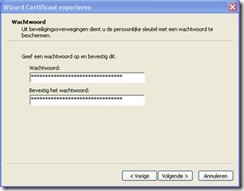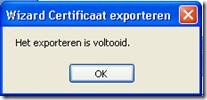Update 7 voor Microsoft Exchange 2007 is vrij gegeven. Downloaden doen je HIER.
Deze update heeft 50 updates. Aangezien microsoft een nieuwe manier van testen/controleren van updates heeft is men niet gelukt om alles opgelost te krijgen met
Roll-Up 6.
Beschrijving van deze update check: KB 960384
- 946449 A non-read report message is sent after you perform a "Mark All as Read" operation against unread e-mail messages in Exchange Server 2007
- 949113 Unexpected modified instances of a recurring meeting may appear when you use Entourage to access a calendar on a computer that is running Exchange Server 2007
- 949114 Duplicate calendar items may appear when you use Entourage to access a calendar on an Exchange 2007 server
- 949464 The customized properties are removed in the recipients’ calendars when you send a meeting request that includes customized properties
- 950115 When a CDO 1.2.1-based application generates a meeting request that includes some European characters in the message body, these characters appear as question marks in Exchange 2007
- 951341 Users cannot read calendar items when they connect Exchange Server 2007 by using certain IMAP4 or POP3 clients
- 952778 Event ID 9874 is frequently logged on Exchange Server 2007 with Service Pack 1
- 953094 The value in the "Messages queued for submission" performance counter on the mailbox role of Exchange Server 2007 increases after a meeting request is delivered
- 954213 All Test commands that are related to the Client Access Server fail when you run the commands on an Exchange 2007 server in a disjoint namespace
- 954741 The UseRUSServer parameter does not work if an administrator has specified an RUS server on a target mailbox server
- 954898 The LegacyExchangeDN attributes for mail-enabled objects are incorrectly set in an environment that contains Exchange 2003 and Exchange 2007
- 955027 The Edgetransport.exe process may crash on a hub transport server that is running Exchange Server 2007 Service Pack 1
- 955462 You notice high CPU usage when the IMAP service is running on an Exchange 2007 Service Pack 1 server that has the CAS role
- 955778 You receive a Non-Delivery Report (NDR) message when you send an e-mail message to a non-SMTP address in an Outlook client that is using Cached mode
- 956069 A Non-Delivery Report (NDR) is generated when an Exchange Server 2007 user tries to send a message to a recipient who has a one-off FAX address that includes any characters that are larger than 0xFF in Unicode
- 956205 Corrupted characters appear in the Subject field or in the Location field of a recurring calendar item after a user adds DBCS characters to a field in a meeting occurrence by using an Outlook 2002 client
- 956275 An Exchange 2007 sender’s address is split into two separate addresses when an external recipient replies to the message
- 956455 The display name appears in a received message even though the property of the user mailbox is set to "Hide from Exchange address lists" in Exchange Server 2007
- 956687 Messages stay in the submission queue after you enable per-mailbox database journaling in an Exchange Server 2003 and Exchange Server 2007 coexisting environment
- 957019 Images cannot be pasted in an Exchange Server 2007 Outlook Web Access message body
- 957071 The MSExchange Transport service may crash intermittently on the Exchange 2007 server
- 957124 You do not receive an NDR message even though your meeting request cannot be sent successfully to a recipient
- 957227 The Exchange Management Console crashes when one or more domain controllers of a top-level domain are not reachable
- 957485 The Test-OwaConnectivity command returns a warning message in Exchange Server 2007 when there is a disjoint namespace
- 957504 The IMAP4 service crashes intermittently, and Event ID 4999 is logged on Exchange Server 2007
- 957683 An IP Gateway can still be used to dial out for a "Play on Phone" request after the IP Gateway is disabled
- 957834 Network shares are deleted and created intermittently by the replication service on an Exchange SCC cluster when SCR is enabled on the Exchange server
- 957947 The Exchange Information Store service may crash when an Entourage client synchronizes with an Exchange 2007 server
- 958091 You cannot update the task complete percentage to any value other than 0 or 100 in Outlook Web Access
- 958093 Voice mail messages are not stamped with the disclaimer that is defined in the transport rule in an Exchange Server 2007 environment
- 958128 Replication messages stay in a queue in a retry state after a public folder database is dismounted
- 958331 The Restore-StorageGroupCopy command may fail in an Exchange Server 2007 SCR environment
- 958444 Event 522 is logged when replication is resumed on a suspended Storage Group on an Exchange Server 2007 CCR or SCR environment
- 958472 An unexpected text string appears at the top of the message body when an Exchange Server 2007 user sends an HTML message by using Outlook Web Access
- 958552 The ByteEncoderTypeFor7BitCharsets setting does not take effect for the US ASCII character set after you install the hotfix that is mentioned in Microsoft Knowledge Base article 946641
- 958638 Exchange 2007 Server cannot parse X-Priority headers from clients that submit X-Priority headers that contain additional comments
- 958803 The EdgeTransport.exe process may stop responding in Exchange Server 2007 when the priority queuing feature is enabled
- 958872 The Map This Address feature in the contact page for an OWA client does not work in Exchange Server 2007
- 959100 Exchange Server 2007 cannot route e-mail messages to mail enabled Non-MAPI public folders that are hosted on an Exchange Server 2003 server
- 959135 Event 9673 occurs when the Microsoft Exchange Information Store service crashes on a computer that is running Exchange 2007 with Service Pack 1
- 959397 An increase in database size is generated unexpectedly when IMAP4 users use a Copy command in Exchange 2007
- 959434 The last logon time is not updated to reflect the logon times that have occurred after users log on to their mailboxes by using the Entourage client in an Exchange 2007 environment
- 959545 A redirection message in Outlook Web Access 2007 is incorrect when the message is translated to Korean
- 959671 The Manage Mobile Devices option is not displayed in Exchange Management Console after a mobile device re-synchronizes with an Exchange 2007 server
- 959952 The Set-Mailbox command does not change the AutomateProcessing attribute for an Exchange Server 2007 user when a regular user mailbox is converted from a room mailbox
- 960291 Outlook Web Access or an Exchange Web Service application does not correctly display a monthly or yearly recurring appointment or meeting request
- 960292 The MSExchangeIMAP4 service may crash intermittently after you apply an update rollup for Exchange Server 2007 Service Pack 1
- 960349 The Exchange Information Store service may crash after you enable tracing for the logon actions
- 961281 An error is returned when you enable SCR from any source in a child domain after you install Exchange Server 2007 Service Pack 1 Rollup 5
- 961395 The Exchange 2007 Unified Messaging server does not update the caller information if an external user makes a call












